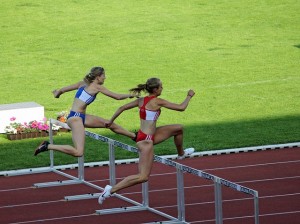Optimizing In-Season Training Programs
If you have ever been a part of or watched a high school team for an entire season, I am sure you have experienced this scenario: the team starts strong and looks great only to finish the season clinging on for dear life with half the team sidelined at one time or another with injuries.
However, some teams seemingly always finish the regular season at their peak and then continue to improve in the post-season. They are, for the majority, healthy and their energy levels alone help them to crush their opponents.
Why does this happen and what are the latter teams/coaches doing right?
Answer: Some coaches are far more effective in managing training stress and utilizing effective in-season strength workouts.
I am going to talk specifically about high school based sports programs. The principles I discuss below apply to club seasons and off-seasons. But, high school athletic programs have to smash five days per week of practices plus games plus other academic responsibilities into a 10-16 week window.
This is an incredible burden on the athlete but also on the coaches. With properly managed training stress and workouts, though, the injury-riddled team can become the perennial post-season powerhouse.
There are two different groups that can affect an athlete’s in-season success and I want to discuss both.
- Private sector coaching individual athletes who are in-season
- Team sport coaches working with a group of athletes over a brief high school season

Private Sector Coaches
This is where I spend my time since I own a private sector performance facility not directly affiliated with any local high schools.
Our biggest in-season conflict is the lack of contact we get with our athletes due to the massive time commitment associated with high school sports. Therefore, our time with them is precious and we need to do as much as we can to assess and increase performance during the one or two times per week we see them.
The ultimate goal with each of our athletes is making sure they are working hard enough through the season to peak at the end of season. This doesn’t necessarily mean they are lifting heavy weights and trying to set personal bests in our gym.
Instead, this means they are working on getting faster and more balanced within their Central Nervous System (CNS) without overstressing their aerobic/anaerobic energy systems so they can practice and perform normally.
Dr. Mel Siff once said, “To me, the sign of a really excellent routine is one which places great demands on the athlete, yet produces progressive long-term improvement without soreness, injury, or the athlete ever feeling thoroughly depleted.” His statement embodies our exact goal with all high school athletes, in-season or otherwise.
Unfortunately, the more common scenario we come across is making sure our athletes aren’t overreaching and heading towards overtraining. This is typically something that is completely out of our hands but we have come up with some unique strategies to combat overreaching and overtraining when we catch it.
In-Season Training Program Strategies in the Private Sector
If you read my previous article about tempo training, you realize I am a big fan and utilize this strategy for every athlete at some point of his or her training.
By incorporating long eccentric periods and explosive concentric periods we can improve an athlete’s deceleration patterns while improving acceleration congruently. Think 30X or 31X (3 counts on the eccentric, no hold or 1 second isometric hold and then explosive concentric return to start).
This accomplishes our first mission, which is making sure our athlete is getting stronger as the season wears on. It won’t force the athlete to overexert with massive load but the CNS will learn how to load the body, increase the stretch reflex, and release tension sequentially for maximal force production.
Our super-secret strategy to monitor and manage our athlete’s in-season training stress is…..drum roll please……self-limiting exercises.
Okay, so it is not THAT super-secret but it really does work great as a secondary assessment tool for us.
When we write an athlete’s in-season training program, there will be at least one self-limiting exercise as well as one accessory single arm and single leg lift.

Examples:
- Self-limiting exercises: jump rope, Turkish get up, bottoms up anything, crawling patterns
- Single arm: alternating dumbbell bench press, single arm row, landmine pressing
- Single leg: split squat, lunge, single leg RDL
We program these at the start of the season and use our eyes as the assessment tool. If we see that split squats or single leg RDLs have suddenly become difficult to balance, the athlete’s nervous system is likely overburdened and likely to get worse if we don’t take action.
At that point we can either regress the movement or substitute a recovery position. If we recognize CNS fatigue in our athlete, our goal is to reset them back to neutral and leave our gym more recovered than when they entered.
Sometimes it is important to just talk with your athlete and ask them how they feel. Most high school athletes that train at a place like ours aren’t looking for a way out, so if they tell us they are beat up, they most likely are and need some recovery.
In our ideal situation, every athlete we work with in-season finishes stronger than ever, is able to play the entire season and peak when it matters most.
Team Sport Coaches
I want to start this part of my article by admitting that I don’t have a lot of experience on this side of the coaching line. However, I have talked with many team coaches over the years from the professional ranks on down to high school coaches.
As with any profession, there are very good coaches out there raising the bar daily and there are many who have fallen behind the times, so my objective here is to raise the level of awareness and generate some discussion about how to improve in-season training at this level.
Team coaches must deal with many athletes that have different personalities and motivation levels. Coaches at this level must recognize which athletes fall into high skill/low skill and high motivation/low motivation categories. There are optimal ways to manage each different category of athlete, which the IYCA does a great job of identifying in their Youth Fitness Specialist certification.
For our sake today, I am going to assume the coach has a good grasp of these concepts.
In-Season Team Sport Programming Strategies

When a coach decides to dive into strength training for his or her team in-season, the goal should be to decrease injury risk and bring the entire team’s strength and confidence up as the season progresses.
By focusing on these qualities in a strength program, the coach has the best chance to keep their top athletes injury free and increase younger or less talented athletes confidence and strength to drive competitiveness during practice.
This ultimately increases the chances of winning and develops a culture of strength and success.
One of the most important parts of injury risk management is recognition of and adjustment to each individual’s training stress, particularly during conditioning.
Again, I recognize I don’t have a lot of experience in this field but I do understand energy systems and what is required of athletes in different sports. Very rare is the case where an athlete needs to do long, sustained conditioning. Most high intensity events in sports last no longer than 10 seconds.
So if I have 10 minutes of conditioning with a soccer player, I would much rather do 20 sec ON/40 sec OFF of 10 yard change of direction sprints for 10 reps than 10 minutes of running laps around a soccer field. The carryover to sport is substantially greater.
When coaches condition like this, three things happen:
- It becomes more fun for the athlete rather than seen as a punishment for not paying attention, etc.
- Athletes are faster and better conditioned during games
- There is far less opportunity for burnout or overtraining
So a team coach does not necessarily need to individualize conditioning programs for each athlete, but rather re-think the way they approach their conditioning.
As the team moves into the weight room for their strength portion of the practice, there are some simple methods that can be used to individualize the training while getting everyone better:
- Movement training
- Progressive overload
- RPE scale
Movement training means doing things like squats, hip hinges, lunges, pushing, pulling and carrying exercises. Simple alternatives are usually the best and most effective. Even top-level athletes constantly work on the basics to become the best at what they do and a team is no different. Strength doesn’t need to look sexy to be highly effective.
Progressive overload is something the coach needs to program before the season starts. The in-season training plan should be created so the athletes have a period where they are pushing harder than usual in the weight room. This typically coincides with the regular season winding down so they have time to recover and feel as strong as ever heading into the post-season.
Finally, a rating of perceived exertion (RPE) (i.e. 1-10) scale of difficulty makes it easy to program design for a large group of athletes. When an exercise that is supposed to be a 7 or 8 on the difficulty scale becomes a 6, the athlete needs to add weight or make the movement more challenging.
For a team coach, the ideal outcome of an in-season strength program is seeing the entire team get stronger, faster, more bulletproof over the duration of the season, and have a rejuvenated, healthy team heading into the post-season.
ADAPT and Conquer,
Coach Jared
About the Author: Jared Markiewicz
 Jared is founder of Functional Integrated Training (F.I.T.). F.I.T. is a performance-based training facility located in Madison, WI. They specialize in training athletes of all levels: everyday adults, competitive adults and youth ages 5-20+.
Jared is founder of Functional Integrated Training (F.I.T.). F.I.T. is a performance-based training facility located in Madison, WI. They specialize in training athletes of all levels: everyday adults, competitive adults and youth ages 5-20+.
The long-term vision for F.I.T. is recognition as the training facility for those desiring to compete at the collegiate level in the state of Wisconsin. Alongside that, to also develop a platform to educate those in our industry looking to make strides towards improving the future for our young athletes.
Find out more about Jared’s gym by visiting F.I.T.
Career Highlights
- 2014 Fitness Entrepreneur of the Year – Fitness Business Insiders
- 2014 IYCA Coach of the Year Finalist
- Volunteer Strength Coach for West Madison Boys Hockey and Westside Boys Lacrosse
- Helped develop dozens of scholarship athletes in 3 years of business
- Instructed Kinesiology Lab at UW-Madison
- Houses an internship program at F.I.T. that started in 2013
- Member of Elite Mastermind Group of Nationwide Fitness Business Owners
 In part 1 of “Why Implement Plyometrics into Your Training Programs” it was important to note that plyometrics could be a great tool to use in your programming to help athletes achieve success.
In part 1 of “Why Implement Plyometrics into Your Training Programs” it was important to note that plyometrics could be a great tool to use in your programming to help athletes achieve success. To keep athletes interested, coaches occasionally need to get creative in their programming. This not only holds interest, but it really is the best thing for the athletes.
To keep athletes interested, coaches occasionally need to get creative in their programming. This not only holds interest, but it really is the best thing for the athletes.





